Originally published Nov. 6, 2013
Think of the average, healthy two-year-old. How would you describe that child?
Do words like strong-willed, emotional, mischievous, or curious come to mind? This child usually knows what they want and will often use the word “no” to exhibit their independence and set boundaries. You will notice they seem secure with themselves.
All of us were two once upon a time and exhibited these same characteristics, some to a larger degree than others. With that in mind comes the question, “Why do we lose the ability to express ourselves openly as adults, particularly with feelings?” How can I find the child within through an Internal Family System or other individual therapy approach? Life experience and interactions with others will affect us positively and negatively. For example, usually we learn that we do not always get what we want, no matter how intensely we scream. It is important to behave maturely and learn we are not the center of the universe. On the other hand, a negative effect may be growing up in a society where there are messages like “nice girls don’t get angry” and “tough boys don’t cry.” I believe this [cultural conditioning] contributes largely to difficulty that women often have saying “no” and setting boundaries. [Conversely,] men who have difficulties with anger and aggression, unable to access more vulnerable emotions [sadness, hurt] are also examples.
Think back and remember, “What messages about behavior, emotions and expectations did I receive early on?”
1) What was the response when I listened or did well in school? How about when I was disobedient, or fought with siblings?
2) How were emotions expressed, and what were common responses? When I felt sad, hurt or angry did I feel safe to share those feelings?
3) What were some expectations that I learned? As an example, some families have the expectation that each child is expected to go to college.
It is essential to realize how these things may have affected our once uncensored, vibrant self, and how they may be present in our current reality. Additionally, it is helpful and enlightening to remember the child that you once were.
To do this, I would like to suggest observing a young child, and asking yourself, “What can I learn? What can I do to remember who I have always been?”
Maybe you can say “no” to things that make you feel uncomfortable or complicate your life. You may discover that you are lacking creativity. What about being direct and not diluting how you really feel? Could you be more independent?
I know a mother who was trying to wipe her tears because she did not want her child to know she was sad. Her child walked up to her and asked, “Mommy sad?”
“No, mommy is happy!” she responded.
“Then why are you crying?” The child asked confusedly.
She realized it was confusing. She could acknowledge that she was sad and accept her child’s concern for her. Then do things with the child that helped her to feel happy.
Have you ever noticed how quickly children can get over emotions? They may feel sad about a friend taking a toy from them. The key is they feel it, go to someone who will listen, and then move on. I do not think these three steps occur nearly enough in adulthood.
My toddler reminds me to find more joy in simple things by asking me if I will run around the table, play with play dough, and go outside with him to see the airplanes in the sky. He is always telling me about the amazing colors he sees which I would never notice otherwise. My family often tells me that finding joy in simple things was easy for me as a young child because I was carefree and easily entertained, always singing, dancing, and catching grasshoppers. This has been easy to forget as an adult. Individual therapy can bring this childhood state back.
Woody Harrelson said, “A grownup is a child with layers on.” Why not spend some time to identify those layers and try some things that help uncover them?

